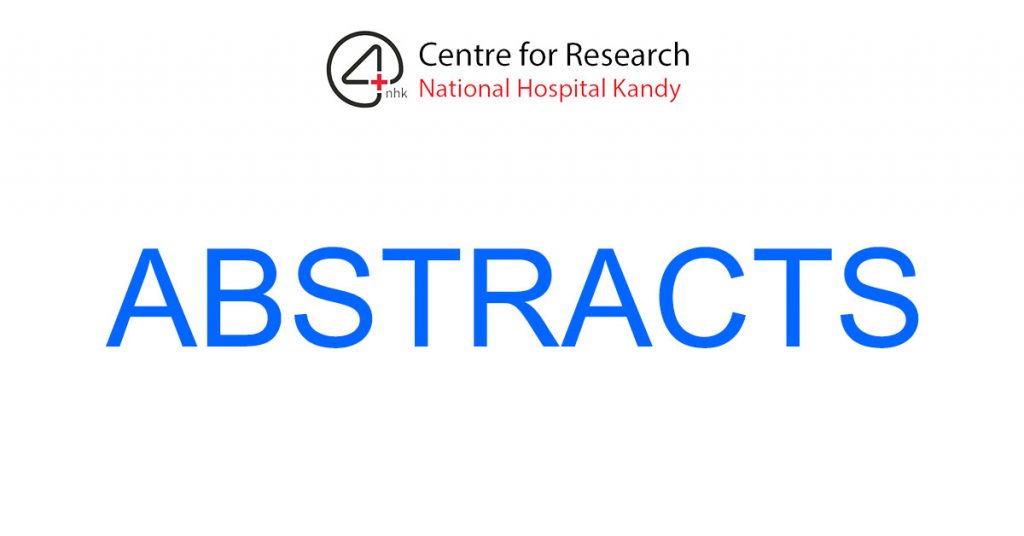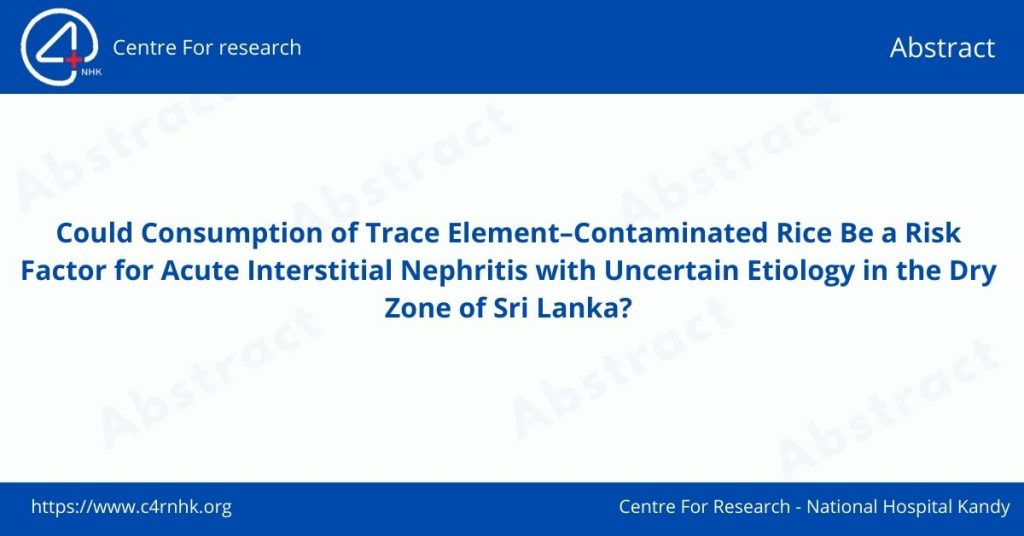Proceedings of the 9th YSF Symposium – 2020 228
ASSOCIATION BETWEEN FLUID AND DIETARY NON-ADHERENCE WITH MORBIDITY AND MORTALITY IN HAEMODIALYSIS PATIENTS ATTENDING TO NEPHROLOGY UNIT, NATIONAL HOSPITAL, KANDY
H.G.N. Erandika1 , N. Nanayakkara2 , M.D.M.L.D.K. Yatawara*3
1Department of Nursing, Faculty of Allied Health Sciences, University of Peradeniya, Sri Lanka, 2Nephrology and Transplant Unit, Teaching Hospital, Kandy, 3Department of Medical Laboratory Science, Faculty of Allied Health Sciences, University of Peradeniya, Sri Lanka
*Corresponding author (email: [email protected])
Introduction
Haemodialysis has been developed as a viable, safe and efficient method which is a form of long-term renal replacement therapy used to remove waste products and fluids from the blood of End Stage Renal Disease (ESRD) patients. It helps to control blood pressure and to maintain the proper electrolyte balance in the body. The estimated global population of ESRD patients undergoing haemodialysis treatment is over 1.1 million with increasing at a rate of 7% per year (3).Although Sri Lankan annual health budget spend high cost to treat the ESRD patients, their mortality rate is alarmingly high due to scarcity of resources and complications.
We aimed to determine the association of fluid and diet non-adherence with morbidity and mortality in haemodialysis patients attending to the Nephrology Unit, Teaching Hospital, Kandy. As the previous literature was not available on similar studies, conducting this type of research will be an eye-opener. Findings of this research will be very effective not only for the optimization of Renal Replacement Therapy (RRT), but also in policy making regarding and dialysis expansion.
Materials and Methods
Study design and setting: A prospective observational study was conducted among 312 HD patients admitted to Nephrology Unit, Teaching Hospital, Kandy since October 2018 to September 2019.
Data collection: An interviewer administered data collection form was used to collect the data from the patients. Informed written consent was obtained from the haemodialysis patients participating in the research. Follow-up study was carried out using the same patients after six month to assess the morbidity and mortality. Demographic data was obtained, including name, district, age, sex, ethnicity, educational level, civil status, monthly income, etiology of ESRD. Assessment of water intake was done using 24 hour recall method.
Ethical clearance: Ethical clearance was obtained from Ethics Review Committee of Faculty of Allied Health Sciences, University of Peradeniya and Teaching Hospital Kandy.
Data analysis: The data was analyzed using the statistical software SPSS (Statistical Package for Social Sciences). Data analysis was done performed by simple descriptive methods using absolute numbers and percentages. Mainly we used chi-square test to assess the relationship between the categorical variables such as, gender, age, educational level, water intake, Intra Dialytic Weight Gain (IDWG), salt intake, protein intake and mortality.
Results and Discussion: A total of 312 HD patients recruited to this study. The mean age of participants was 50.6 (SD=13.0581) years with the youngest participant being 17 years of age and the oldest being 83 years of age. Among those 312 patients, male:female ratio is 9:4. Diabetic nephropathy (38.1%) and chronic hypertension (27.6%) are the highest level of etiological factors of CKD in this study.
In the study group, non-adherence to therapeutic fluid, salt and protein intake were 73%, 46% and 58% respectively. According to the previous literatures in United States and Turkey reported that the fluid non-adherence were 54% and 68% (1;4). Statistically significant relationships were found between water intake and gender (P=0.005), educational level (P=0.042), and protein intake (P=0.000). Males had high fluid intake (Figure 1) and low protein intake compared to females. Moreover, high fluid intake and low protein intake reported among participants who studied below O/L and up-to O/L education than other educational categories. Salt intake of this study group was in a satisfactory level compared to other two factors. More than 50% of patients had high level of IDWG than recommended level which is 0.5 – 1.0 Kg/day. There is a relationship between IDWG and age (P=0.030). High IDWG was more prominent in 51-60 age category.
Figure 1. Distribution water intake with gender
About 73% of this group has admitted to the hospital during period of 6 months due to various medical conditions. Low protein intake was associated with increase hospital admissions and high fluid intake was the key factor to increase the morbidity symptoms. Loss of appetite and lack of sleep were presented among higher number of patients compared to other morbidity symptoms such as, hypertension, edema, dyspnea and muscle cramps. In this research study, 76 deaths had reported during the 6 month follow-up period. Hence, mortality rate was 24.35%. Fluid intake >1000ml per day, 3kg <IDWG, Low protein intake and low protein intake can be suggested as crucial factors for increased mortality rate.
Table 1 : Associated factors for increased mortality rate among HD patients
A study in Colombia introduced predictable factors for increased mortality in HD patients (2). Age and gender included as traditional factors and anemia and hypoalbunemia suggested as non-traditional factors.
Table 2. Compatibility of Colombian study results with current study
Conclusions and Recommendations: Results of this study proposed that the fluid and dietary non-adherence is attributing to poor outcome of these patients. Lack of knowledge is a major contributing factor among the underlying causes and urgent intervention is warranted. Patient education, identification of at-risk for non-adherence and assisting patients to manage difficulties with life-style changes related to HD are important elements in promoting non-adherence. Special attention to modify these factors will improve the survival of HD patients. Factors such as quality of life (QoL) or the presence of depression could also be considered in future studies.
References
[1] S.I. Bame, N. Petersen, and N.P. Wray. “Variation in hemodialysis patient compliance according to demographic characteristics’, Social Science & Medicine. Pergamon, 37(8), pp. 1035–1043. 1993.
[2] J.Coronado, et al. “Factors Associated with Mortality of Patients on Hemodialysis”, Journal of Nephrology & Therapeutics. OMICS International, 6(6), pp. 1–7. 2016.
[3] D. Fincham, A. Kagee, and M.R. Moosa, “Dietary and fluid adherence among haemodialysis patients attending public sector hospitals in the Western Cape”, South African Journal of Clinical Nutrition, 21(2), pp. 7–12. 2008.
[4] B. Kara, K. Caglar, and S. Kilic, “Nonadherence With Diet and Fluid Restrictions and Perceived Social Support in Patients Receiving Hemodialysis”, Journal of Nursing Scholarship. 39(3), pp. 243–248. 2007.
![]()



